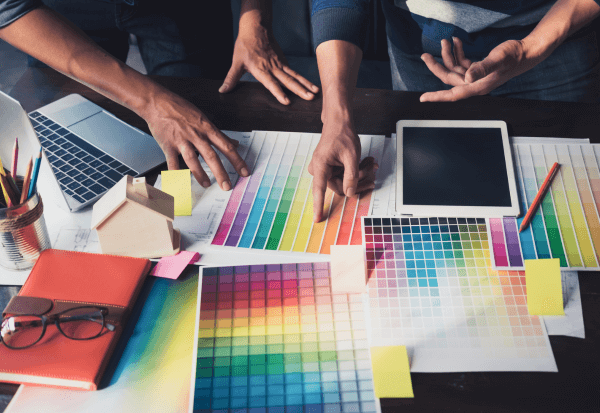It would not be hyperbole to say that design is at the core of creating engaging, relatable, and personalized user experiences. In fact, research from Forrester shows that, on average, every dollar invested in UX brings a 100 in return. That’s an ROI of 9,900%.
Moreover, it is estimated by HubSpot that 88% of online consumers are less likely to return to a site after a bad experience. It is no surprise then that Rule #1 of Google’s “Ten Things” philosophy is “Focus on the user and all else will follow”.
As a result, design needs to be deeply rooted in human behavior and what works and doesn’t for the users of a product. However, design also needs to guard against the individual human biases of those trying to visualize and design an experience vicariously.
Finding someone who not only understands the business goals but also knows how to translate them into actual user requirements and realize them through design is critical for any customer-centric business. Hence, a product or user experience designer assumes great significance for any organization that is looking to reimagine customer experiences and create greater stickiness.
However, the brilliance of an individual product or experience designer might not be enough as it can lead of biases or limitations creeping in that are highly individualistic. Hence, it is important to embrace a team-based approach to build more balanced experiences that are truly oriented towards the customers. This does require significant investment in creating a body of shared knowledge, presumptions, vocabulary, and cultural practices.
Assembling a well-balanced team that can adopt a design thinking approach requires more than just picking the right candidates and appointing them in specialized positions. Should we assess the skills required to design other people’s experiences and if an individual on board can do it, or is there more to design than just producing design output, such as user flow, wireframes, and visual design? The most crucial decision for organizations could still be whether a team or one person should be assigned the task of experience design.
To put things in perspective, compare a sprint race between two competitors to a relay race between a team of four athletes where the team passes the baton and is required to help each other in winning the race. Design activities are more like relay races where each team member contributes effectively in their specialization and, most importantly, helps to create an environment that is open to innovation. Approaches to design issues are more likely to be the designer’s own ideas, which specify how a ‘user’ should react in a particular situation. Therefore, the process of design is more involved than a task that one person can complete by themselves. The collaborative design method, which is now becoming more and more prominent, is something that needs to be fostered.
The fields of user experience (UX) and user interface (UI) design are particularly beneficial for collaborative design. To create intuitive and user-centered digital experiences, UX and UI designers frequently work in collaboration with researchers, developers, product managers, and other stakeholders.
To create design solutions that are more efficient, collaborative design enables a thorough grasp of user wants, preferences, and pain spots. It encourages interaction between developers and designers.
In design thinking, working in a team can often be far more practical than working alone. An idea can be developed considerably more quickly and easily from a group of individuals with diverse perspectives and creative abilities. Due to the rapid pace of the innovation process, this is very beneficial for an organization as it can significantly enable competitive advantage.
These are the important factors to be considered when embracing a collaborative and team-based design approach-
- Diversity: A team as diverse as designers, business analysts, architects and developers bring to the table different strengths, skills, and backgrounds. This diversity enhances creativity and problem-solving, leading to more innovative design solutions.
- Collaboration: The breaking of biases requires a fresh perspective and looking from varied points of view, leading to more refined ideas. Collaborative design often results in more mature design.
- Expertise: The field of UX design today requires expertise such as research, interaction design, and visual design. This expertise can lead to an improved quality of design overall.
- Turnaround: With multiple designers working in parallel, a team can, more likely than not, complete projects quicker than an individual, allowing for faster time-to-market.
- Reduced Risk: Teams can reduce design-debts through collaboration and thorough design reviews, in turn reducing potential issues earlier in the process.
- Feedback and Iteration: Creates an environment that provides built-in feedback loops, allowing for constant iteration and improvement.
In collaborative design, participants contribute ideas and explore potential solutions to the problems the product is intended to solve during a series of meetings and workshops. Using this approach greatly increases the probability of the final product being well-designed, efficient, and suited to the needs of all stakeholders. When used as a methodology for a variety of projects and at different stages of some projects or initiatives, the design thinking approach may be incredibly productive.
Teams can construct prototypes, test assumptions, generate a wide range of new ideas and viewpoints, and develop a shared vision of what they want to accomplish by applying design thinking. Design thinking’s primary objective is innovation and creativity promotion, however a collaborative design approach can also lead to creating a team that is highly integrated and primed to deliver experiences that are greater than the sum of its parts.

is passionate about designing seamless, impactful digital experiences. As a UX design strategist and consultant, he believes that design thinking can transform problems into design opportunities that simplify and enhance people’s lives. Over the years, he has led design teams through the full design lifecycle, delivering engaging user experiences across a range of industries, platforms, and enterprises. He currently heads the UX Design practice of Product & Digital Engineering Services at Happiest Minds.





